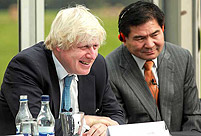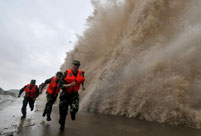 |
| Kasper Rorsted is the CEO of Henkel. (Photo courtesy of Rorsted) |
China has experienced rapid economic growth over the last two decades, registering double-digit expansion rates. Now its growth dynamics are easing: in 2012, China recorded GDP growth of 7.7 percent, the lowest increase since 1999. Moreover, worries about the stability of the financial sector, bloated by the activities of so-called shadow banks, have strengthened. Similar developments can also be observed in other emerging markets. At the same time, countries such as India and Indonesia are experiencing currency turbulences. Does this mean that we are witnessing the end of the emerging markets’ success story, particularly the BRIC countries – and especially China’s with its exceptionally high growth rates?
No. To talk of a “China crash” is exaggerated. The Asian markets have great long-term potential with solid underlying fundamentals. Despite first signs of recovery, the crisis in Europe remains, characterized by high national debt, recession and high unemployment in many countries. By contrast, even in the first half of 2013, China has remained a growth driver – also for Henkel. With sales of more than 1 billion euros, China is one of Henkel’s top three markets. Again in the first half of 2013, sales in China increased double digit. In the Asia-Pacific region, Henkel generated around 2.6 billion euros in revenues in 2012, representing about 16 percent of total sales.
Consequently, China and Asia are among the markets that I visit most frequently to meet with employees, customers, suppliers and economic experts. This week, more than 1500 participants from business, science and politics meet at the Summer World Economic Forum in Dalian, China. The topics on the agenda include the transformation of industrial systems, how to promote innovation, and the stabilization of social and community development. We have to accept that a country with more than 1.3 billion people and a history that stretches back thousands of years cannot always be explained by applying our western standards. If we wish to understand one another, we need to talk more with rather than about each other.
When people speak of China’s “crisis,” reference is usually made to the following factors: The government has kept the currency low for too long while at the same time making too much money available; this in turn has led to poor investment decisions, industrial overcapacity and real estate bubbles. At the same time, China is no longer capable of fulfilling the role of the “work bench of the world,” because of declining demand among its customers in the west.
The critical questions are: Will the market forces in China develop strongly enough in order to remain competitive and deliver stable long-term growth? Are the state-run enterprises and the banking sector in a position to continue operating in a free competitive environment or to absorb higher interest rates? Will China succeed in transforming from growth driven by strong state investment policy to steady growth based on private sector investments, a growing services industry and private consumption?
However, such questions ignore the quantum leap that China has made in the last 20 years and the extent to which the living conditions have improved for hundreds of millions of people. The country is undergoing a transition to the next phase of its development. Although the upward trend of economic development in China has eased recently, the slowdown has not been of China’s making alone; it is based at least in part on weaker demand coming out of Europe. Moreover, slower growth is also part of a deliberate policy. China’s new government has signaled its willingness to introduce economic reforms; the aggressive approach to growth of the past is being revised. And even with a lower growth rate, China’s economy delivers a level of dynamism that Europe’s finance ministers can only dream of.
For a long time, it appeared that growth of at least eight percent was necessary in China in order to provide millions of job-seekers with work and avoid social tensions. However, today such growth rates are no longer indispensable. The number of people looking for work has declined in the course of time. While the average between 1991 and 2000 was 8.7 million per year, the figure today is no more than around 5 million. At the same time, a structural change is taking place – toward greater emphasis on innovation, private consumption and services.
Premier Li Keqiang considers this development to be of particular importance for the future. Urbanization and domestic consumption are to become the driving forces of Chinese economic development. Supported by a growing middle class, retail sales have recently risen by double-digit percentage rates.
At the same time, Chinese retail is benefiting from digitalization. Around 560 million Chinese are already online today, with online shopping currently attracting around a quarter of a billion customers. In the coming year, the volume of online purchases is expected to reach 370 billion euros.
Therefore, since 2009, the growth rate in this segment has been seven times that of China’s GDP over the same period.
Moreover, outside the consumer sector, industry is still expanding. China is becoming the most important market in the world for an increasing number of producers. The country is already the world’s largest machine constructor – manufacturing more than twice the volume produced by the United States. The automotive industry is also booming. Only in the USA more cars and pickups were sold last year.
The fear of a real estate bubble also appears to be overstated, despite reports of booming prices in the biggest Chinese cities on one side and huge new-build projects which remain empty due to planning mistakes made by ambitious regional politicians on the other side. In China, the cities still only account for about half the population. Over the next few decades, urbanization can be expected to advance rapidly. By 2025, the number of cities in China with more than one million inhabitants is predicted to rise to more than 220. In Europe, meanwhile, the number of million-plus cities is not expected to go beyond 35.
This rate of expansion will also increase demand for modern and efficient infrastructure – firstly, in order to generate further growth, and secondly because, in view of increasing environmental impacts, the issue of sustainability will gain importance in China. Indeed, in the coming years, the Chinese intend to substantially expand their rail network. In addition, old power generating plant facilities will be replaced by modern, more efficient plant.
There is no doubt that China will face major challenges in the coming two decades – economic, political and social. We will see phases of increased volatility and uncertainty. However, that is the price for a growth rate that, overall, will continue to be significantly above the rate of global economic growth.
Consequently, the country will continue to offer significant opportunities to global companies from Germany. In order to meet the rising demand for industrial adhesive technologies in China and the Asia-Pacific region, Henkel is expanding its local production capacity. We will be opening the largest adhesives manufacturing facility in the world in September in Shanghai. Our Beauty Care business has tripled its sales there in just a few years, to more than 100 million euros.
If there is a problem for China’s growth at the moment, the main cause lies in Europe where the fundamental risks are still remaining. The exports of China and indeed that of the entire Asian region would be impacted, if the debt crisis was to reignite again and European demand underwent further decline. Affluence and growth – and associated with this, political stability – in China and its neighbors depend on developments in Europe. Consequently, we in Europe should concentrate first and foremost on getting our own house in order, before we wave a warning finger at China and talk down the Asian markets as being weaker than they really are. For there, the future has only just begun.
The author is the CEO of Henkel.
 2013 Colour Me Rad 5K run held in Canada
2013 Colour Me Rad 5K run held in Canada China's destroyer Qingdao sails out of Sydney Harbor
China's destroyer Qingdao sails out of Sydney Harbor Chinese tycoon aims to restore London's Crystal Palace
Chinese tycoon aims to restore London's Crystal Palace A staple of southern Chinese people
A staple of southern Chinese people Typhoon Fitow approaches China
Typhoon Fitow approaches China Tourists take pictures beside Qinghai Lake in Xining
Tourists take pictures beside Qinghai Lake in Xining New couples take wedding photos during holiday
New couples take wedding photos during holiday Serena Williams stumbles through to quarterfinals
Serena Williams stumbles through to quarterfinals Thailand Mobile Expo 2013 kicks off
Thailand Mobile Expo 2013 kicks off Photo collection of Chinese Navy
Photo collection of Chinese Navy Dense haze envelops N China
Dense haze envelops N China Twins Culture Festival kicks off in Beijing
Twins Culture Festival kicks off in Beijing UNESCO world heritage site: Montale Tower
UNESCO world heritage site: Montale Tower Egyptian protesters clash with police amid war anniv. celebration
Egyptian protesters clash with police amid war anniv. celebration Serena Williams wins second China Open title
Serena Williams wins second China Open titleDay|Week|Month